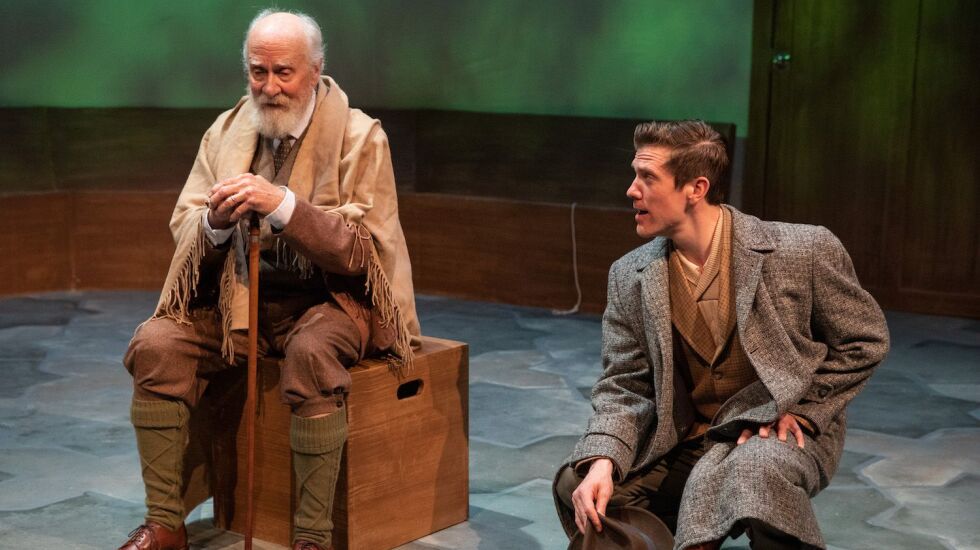
For a drama centered on the intense relationship between one the world’s most dazzling wordsmiths and a show-stopping athlete of almost otherworldly grace and physical prowess, “Shaw vs. Tunney” is an often ponderously static piece.
There’s certainly potential in playwright Douglas Post’s world premiere play for Grippo Stage Company. The script explores the real-life, decadeslong friendship between world heavyweight boxing champion Gene Tunney and Irish playwright George Bernard Shaw. But “Shaw vs. Tunney” limps and falters where it should float and sting, hampered by a plot anchored not in storytelling but in philosophical debate.
On stage, Tunney and Shaw aren’t much deeper than figures sketched on a storyboard. It’s possible that Post’s source material — “The Prizefighter and the Poet,” a book penned by Tunney’s son Jay R. Tunney — did better by its characters. But under Nick Sandys’ direction of the stage production, it quickly becomes tough to care much about Tunney (Sam Pearson), Shaw (Richard Henzel) and Tunney’s wife, Polly (Maddie Sachs).
Pearson’s Tunney is a voracious reader and a devout Catholic obsessed with showing the world that book smarts and a vastly inquisitive intellect can coexist with unshakable faith, just like brute strength in the boxing ring doesn’t preempt an insatiable quest for education outside the ring.
Shaw is key to Tunney’s highly defensive mode of existence: If he can hold his own with the author of works including “Saint Joan,” “Major Barbara” and “Pygmalion,” Tunney can prove his own worthiness to the world. So with new bride Polly in tow, Tunney cuts short an extended honeymoon in favor of a visit with Shaw at his island home in the northern Adriatic Sea.
The Tunneys are greeted by an alternately bemused and prickly Shaw. Post follows the thread of the two men’s conversational relationship from 1928 through 1948. The primary problem with “Shaw vs. Tunney” is that it’s a discussion rather than a journey. That discussion takes place primarily in a series of two-person scenes, the odd man (or Polly) out relegated to sitting on stage in shadow.
That the script is prone more to talk than action isn’t the only problem. In terms of character development, Polly is barely a wisp ahead of Shaw’s always offstage wife. Like Shaw’s wife, Charlotte, Polly exists only as a vessel for her husband’s hopes and dreams. In one particularly ludicrous moment, Tunney leaves his very possibly dying wife moaning in pain so he can visit with Shaw.
Tunney never comes across as much more than an angry, defensive, deeply self-absorbed man-child. He spins monologues from resentment, lamenting that he’s been egregiously disrespected by both an uneducated press corps (who resent him because of his passion for reading) and the elitists who want to see him knocked back to his working-class roots. And although Tunney describes his feats in the ring with the swagger and pride of a champion, he has nothing but contempt for the “mob” that makes his championships possible.
As Shaw, Henzel delivers the acerbic, razor-sharp wit Post’s script demands. Still, Post’s script turns Shaw into a series of epigrams more than a fully rounded individual. As Tunney, Pearson has the broad-shouldered bearing of a boxing champ. It serves him well, especially in the fight reenactments, when he merges the grace of a ballet dancer and the menace of a hired killer.
Despite the larger-than-life figures of its title, there are no heroes and nobody worth rooting for in “Shaw vs. Tunny.” There are, however, two killer moments that reveal the potential in the story, both occurring as Tunney offers a blow-by-blow rendition of prize fighters. With Henzel and Pearson circling each other like bantam roosters primed for a cockfight, the action goes from vanilla to thriller as Tunney’s match and rematch against George Dempsey play out.
Abbie Reed’s ultra-minimalist, budget-conscious set is adequate if generic. There’s little visible difference between the Adriatic isles and London, but there’s also little reason to care. Rachel Lambert has the cast outfitted in tweed and taupe, and like the set, there’s no specificity to the costume design: It’s not timeless so much as generic.
There’s bones of a solid play in “Shaw vs. Tunney.” Unfortunately, they’re without flesh.







